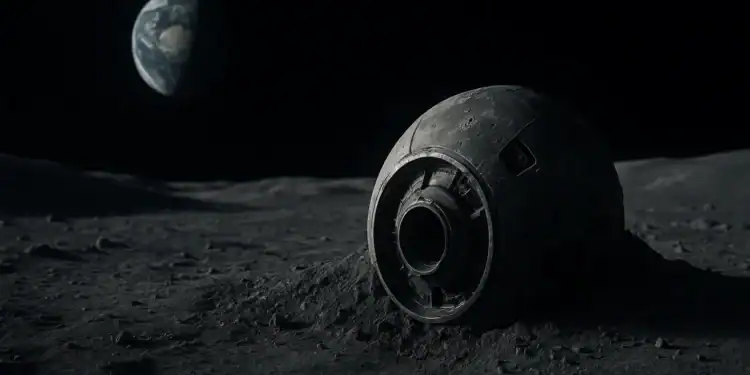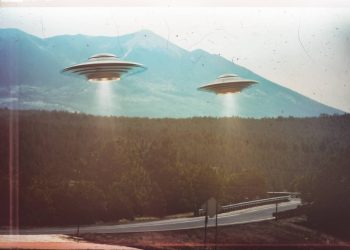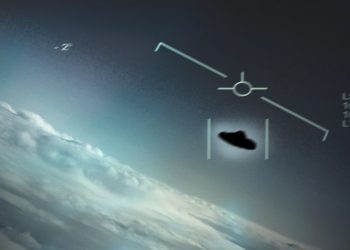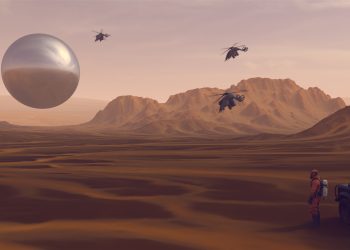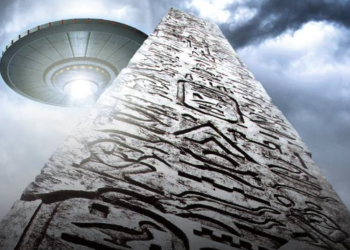What if the greatest discovery in human history isn’t waiting in a distant galaxy… but buried in silence beneath the dust of our own Moon?
For most of human history, we looked up at the Moon with wonder. It was a symbol, a guide, a mystery. Then, in 1969, humans finally touched its surface, and found, as expected, rock, dust, and silence.
But what if we missed something?
The Moon, unlike Earth, is a cosmic time capsule. No atmosphere, no liquid water, no tectonic plates. No weather to corrode. No oceans to drag remnants beneath their waves. No wind to scatter. In fact, conditions on the Moon have remained largely unchanged for billions of years. Anything that landed there,whether a natural meteorite, a human probe, or something far stranger, could remain preserved almost indefinitely.
This fact has led some scientists and thinkers to wonder: what if something did land there? Not from Earth. Not from our time. Imagine. Just imagine.
The Oldest Surface in the Inner Solar System
The Moon formed shortly after Earth itself, around 4.5 billion years ago, likely the result of a violent collision between the early Earth and a Mars-sized body. Since then, it has served as a passive observer to the evolution of our solar system.
Its surface tells a story no other celestial body can. While Earth has erased its past with continental drift, volcanic activity, and erosion, the Moon has done none of that. It is a preserved relic. A memory. And it may be holding more than we think.
So just by using common sense, if you’re going to look for ancient, technological artifacts from a planet other than ours, look where things can survive for billions of years. And the Moon, airless, geologically dead, stable,is one of the best preservation environments in the solar system.
A Logical Target for Interstellar Probes
Now imagine a distant civilization seeding the galaxy with interstellar probes, durable, autonomous, and built to endure deep time.
We’ve done something similar with Voyager 1 and 2, and Pioneer 10. Our probes are slow and few. But a far older and more advanced species could have launched thousands, maybe millions, across space,blindly, systematically, over epochs.
If just one of those alien probes ever passed through our solar system, it might not slow down. It wouldn’t need to. But it could be pulled in, by Jupiter, by the Sun, or by the Earth-Moon system.
Here’s the thing: if a high-speed object like that struck Earth, it would almost certainly burn up in the atmosphere, disintegrate in the ocean, or be destroyed by tectonic forces and time.
But the Moon is different. No atmosphere. No oceans. No erosion. Just rock, dust, and silence.
A probe crashing into the lunar surface,even at high velocity,might break apart… but pieces could survive. Metal fragments. Unusual alloys. Embedded structures. Preserved for millions of years beneath layers of regolith. Not by design. Not by intent. Just by the nature of where it fell. It is only logical. And the best part is, we have a couple of more places to search for in the solar system. Any of the Moons of Jupiter or even Saturn possibly could have objects rashed on their surface.
Interstellar Visitors: We’ve Seen Them
Until recently, the idea of interstellar objects visiting our solar system was mostly hypothetical. But that changed in 2017.
That year, astronomers spotted a cigar-shaped object hurtling through our solar system at incredible speed. It was the first confirmed interstellar visitor, and it was named ʻOumuamua, meaning “a messenger from afar arriving first” in Hawaiian.
ʻOumuamua was strange. It didn’t behave like a comet or asteroid. It had no tail. Its acceleration was unusual. Its shape was unlike anything seen before. Harvard astronomer Avi Loeb even suggested it could be artificial,a discarded light sail or fragment of alien technology. Most scientists disagreed, favoring natural explanations. But the seed was planted.
In 2019, a second interstellar object arrived: 2I/Borisov. This time it looked more like a standard comet,though with unusual chemical composition.
And in 2014, long before these two, sensors detected an object called CNEOS 2014-01-08, now believed to have interstellar origin based on its velocity and trajectory. It crashed into the Pacific Ocean near Papua New Guinea. If confirmed, it would be the first known interstellar object to have struck Earth. Loeb beleives this could have been a technological artifact. Since it crashed to Earth, it is almost impossible to find. However, had it crashed on the surface of the Moon, the story would be completely different. Future lunar missions could have found it.
So, as of writingh we have three interstellar objects that we have found. In less than a decade. Which raises a question: how many more have passed by, unnoticed? And how many may have struck the Moon?
Buried Beneath the Dust
The Moon is constantly bombarded by micrometeorites. Its surface, known as regolith, is a fine layer of broken rock and dust, formed by billions of years of impacts. This layer can be several meters thick in places. And beneath that dust… lies mystery. At least for now. What the apollo astronauts explored on the Moon is literally insignificant. That is why I am partifucalry excited about Artemis, and the future. Becasue if an alien probe (or any alien technology) landed or crashed on the Moon tens of millions of years ago, it’s likely that it’s now buried, shielded from further damage. It wouldn’t need to be large. A meter-wide sensor. A metallic shard. An engineered alloy. A signal recorder. Something that might not even be visible from orbit.
And that’s a problem. Because we’ve barely begun to explore the Moon’s subsurface.
We’ve Only Scratched the Surface
Between 1969 and 1972, twelve astronauts walked on the Moon. They explored just six locations, all near the equator and on the near side. Since then, lunar missions have been limited to orbiters, landers, and rovers, most of them covering small areas.
Today, the Moon is becoming a focus again. NASA’s Artemis program aims to return humans to the surface by the late 2020s, with the long-term goal of building a sustainable lunar presence. China, India, Russia, and private companies like SpaceX and Blue Origin also have ambitious lunar plans.
New missions are beginning to probe the Moon in greater detail than ever before. China’s Chang’e program continues to expand its reach with successful landers, sample-return missions, and upcoming south polar expeditions. Instruments like NASA’s Lunar Reconnaissance Orbiter (LRO) have been mapping the Moon for over a decade, yet only a fraction of the surface has been studied up close, and virtually none of the subsurface.
Several upcoming efforts, including crewed missions under NASA’s Artemis program, aim to establish a long-term human presence. But until we dig, scan, and explore beneath the regolith, vast regions of the Moon,and any secrets they might hold, will remain untouched.
Though smaller than Earth, the Moon still holds over 38 million square kilometers of surface, enough terrain to hide secrets in craters, crevices, and deep beneath the dust.
The Birth of Lunar Archaeology
In time, we may develop the tools and missions necessary to search not just for water ice or minerals, but for anomalies. Artificial patterns. Unusual materials. Electro-magnetic signatures. Things that don’t belong. Things that we did not bring to the Moon.
Lunar archaeology may one day become a field of study. And it won’t just be about exploring human history (space archaeology), like the remnants of Apollo modules or robotic landers. It could become a tool for uncovering non-human history. A cosmic archaeology.
If even a single fragment of alien engineering were found, the implications would be staggering. It would mean we are not alone. That we are not the first. That others have walked, or drifted, through the stars before us.
And we might not have to go far to find them.
It’s tempting to look outward, to scan exoplanets, listen for distant radio waves, and dream of civilizations light-years away. But maybe, just maybe, the first evidence of intelligent alien life isn’t waiting in some distant galaxy. Maybe it’s beneath our feet. Or just a three-day journey away. Maybe we should stop looking only at the stars. And start digging.



